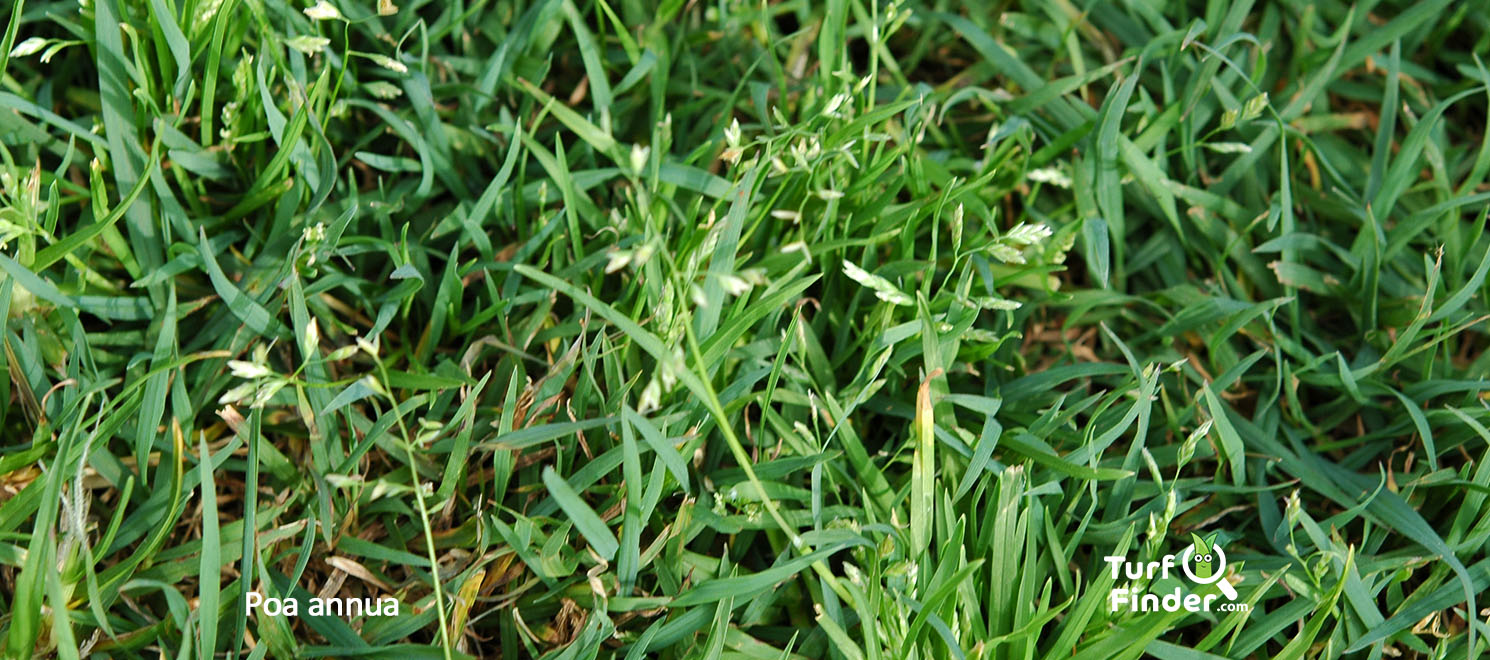
Other common names:
Winter grass.
Description:
Poa annua can have either a tufted, slightly creeping or creeping (prostrate) growth habit depending on the genotype due to the extremely diverse grass species. There are commonly two forms of Poa annua which include an annual genotype, which is commonly tufted and a perennial genotype, which is (semi-)prostrate. Huff (2002) goes even further and breaks down the perennial genotype into two further categories, (i) a short lived, perennial type adapted to various turf (lawns, fairways, tees etc.) referred to as a “turf-type”, and (ii) a long-lived, perennial type that thrives under the extremely close mowing heights of golf greens, referred to as “greens-type”. The variation present within the species allows herbicide resistance and a high degree of regenerative potential.
Culms (stems) of the Poa annua plant can be up to 30 cm if left unmown. The soft, narrowly linear, flat, smooth leaves are up to 3.5 mm wide. Foliage is often lime green in colour for the annual genotypes and darker green in colour for the perennial genotypes. In rare instances a Poa plant can have no inflorescence or more commonly they can produce multiple to several inflorescence (panicles) which can grow up to 7 cm if left unmown. Perennial genotypes often produce fewer inflorescences and form patches from short stolons (McCarty et al., 2008). Spikelets of the inflorescence are up to 5.5 mm are closely spaced with 3-7 flowers (Darke et al., 1994). Poa has a shallow fibrous root system that can establish well, particularly if the Poa annua plant or plants are within a routinely mown, well maintained sward.
Distribution:
Poa annua is widespread throughout Australia and is ranked in the top five of the most widely distributed plants in the world (Fenner, 1985). Poa annua is regarded as an environmental weed in Victoria, New South Wales and Western Australia. Further information on the distribution of Poa annua can be found within AusGrass2 (Simon, 2012).
Lifecycle:
Annual and perennial biotypes exist. Both forms produce by seed plus short stolons for the perennial biotypes. The annual genotype can complete its lifecycle in approximately 2 months. However, during this short period, substantial damage can take place if seed is able to germinate freely. It has been estimated that annual Poa seed densities are commonly 200,000 per square metre in infested lawns, which is equivalent to 20 seeds in every square centimeter (Massey University, 2013). Poa annua can flower and establish at any time of the year, although this is less likely under dry conditions. Inflorescence emerge after a growing point changes from the vegetative to the reproductive state. Subsequent elongation of the stem (now called a flowering culm) elevated the inflorescence so that developing seed can disperse and provide new plants when conditions for germination and seedling growth are favorable (Turgeon, 2003).
Cause:
Annual Poa annua predominantly dominates turf that is weakened by wear, deficient in nutrients, excessively wet and grows in compacted soil. Perennial Poa is usually found within closely mown golf courses, within tees to greens under routine high maintenance, Both biotypes are seen in major sports stadia across Australia that either has a standalone ryegrass (Lolium spp.) or combination of green couch (Cynodon spp.) and ryegrass playing surface. It is likely that Poa seed has been brought in by various means (wind, footwear, unclean machinery, contamination etc.). Poa annua prefers a pH of 6 to 7 and flowers prolifically at very low cutting heights which also disrupts the quality and appearance of the turf surface.
Environmental triggers:
“In the USA approximately 80% of Poa annua germination occurs in the autumn in a 60 day window; studies here in Australia indicate that the main flush of germination also occurs in the autumn with some germination occurring in the spring. However, the more perennial types can flower all year round with a major pulse in the late winter and spring (Neylan and Peart, 2009).” The potential for an explosive weed population is possible given there is often a very large seed bank. Seedbank persistence can be 4-6 years (WAH, 2013). Favorable environmental triggers include:
Temperature:
- Optimum temperature range for germination is from 10°C to 16°C. Studies in the USA by Beard et al. (1978) identified 13°C as a uniform but low germinating temperature.
- McCarty et al. (2008) suggest to apply pre-emergence product in late summer when air temperatures reach 24°C for several consecutive days) in an effort to help limit/prevent germination of Poa seed.
- Active growth between May and November and occasional growth from December to April has been observed (WAH, 2013).
- Flowering from October to December and occasional flowering from January to September has been observed (WAH, 2013).
- Poa shows poor heat and drought tolerance. Often in subtropical and some temperature regions, when warm weather is received following a cool and or wet period, Poa annua may decline or even die off. A total kill may not be observed as some Poa plants may have developed a heat/drought resistance and will remain until the following autumn.
Rainfall/water presence:
- Grows aggressively under moist conditions.
Frost:
- Lethal temperature for 50 % of population, LT50) is -14.3°C (Hoffman & DaCosta, 2011).
Growing degree days:
- A baseline temperature of 10°C is used to calculate GDD. - In Michigan, USA flowering pulses occurred at 363 to 433 degree days (Danneberger & Vargas, 1984).
References
Control options:
Disclaimer:
Turf Finder or its developer accepts with no responsibility for any consequences whatsoever resulting from the use of any information or product(s) listed herein. Products are to be applied as per label instructions.
OxaFert 16-2-6
Pre-emergent herbicide with fertiliser 16 (N) - 2 (P) - 6 (K) - 16 (S) + 1.5 (Fe) and 0.2 (Mn)